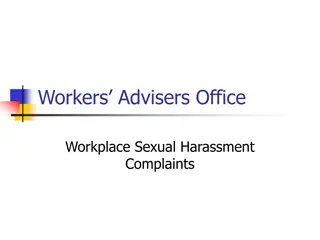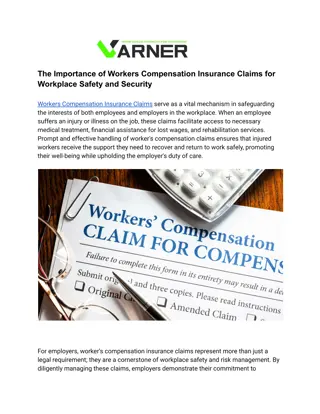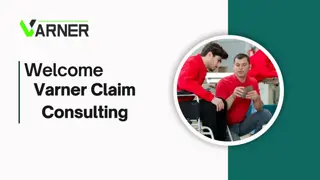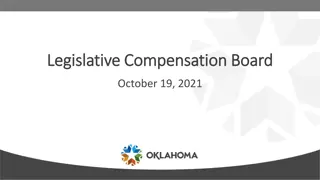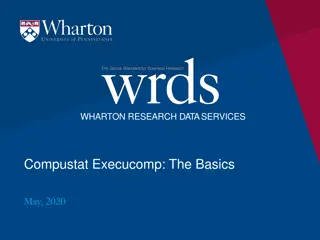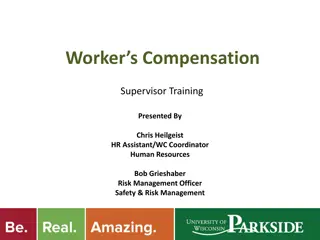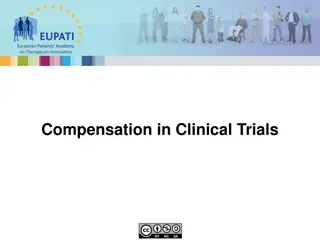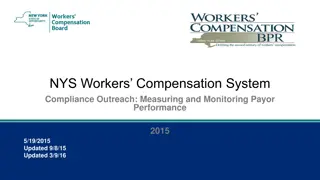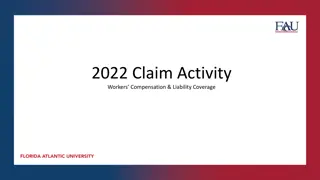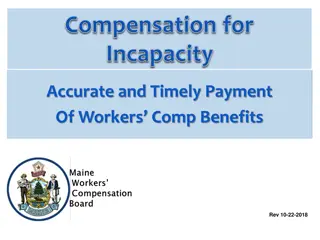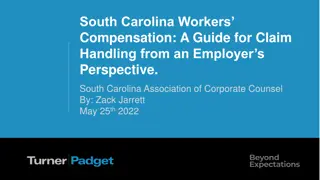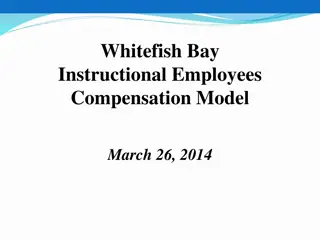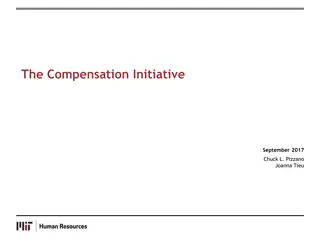Workers’.Compensation Training
Explore the comprehensive Workers Compensation Training Program, covering essential topics like insurance coverage, work-related injuries, legal aspects, benefits for employees and employers, and more. Gain insights into the purpose and benefits of workers compensation laws to ensure a safe workplace environment and proper assistance for injured workers. Enhance your knowledge to comply with regulations and promote workplace safety effectively.
Download Presentation

Please find below an Image/Link to download the presentation.
The content on the website is provided AS IS for your information and personal use only. It may not be sold, licensed, or shared on other websites without obtaining consent from the author.If you encounter any issues during the download, it is possible that the publisher has removed the file from their server.
You are allowed to download the files provided on this website for personal or commercial use, subject to the condition that they are used lawfully. All files are the property of their respective owners.
The content on the website is provided AS IS for your information and personal use only. It may not be sold, licensed, or shared on other websites without obtaining consent from the author.
E N D
Presentation Transcript
Workers Compensation Training
Workers Compensation Training WELCOME! 2
Introduction Workers compensation insurance coverage is a benefit mandated by law in most states. Regardless of how safe an employer may try to make its workplace, on-the-job accidents and job-related illnesses occur. This session will provide you with knowledge of workers compensation laws and our workplace safety rules so that your employees receive the full and correct benefit of the law and that we keep our on-the-job injuries and costs as low as possible. 3
Agenda What is workers compensation? Workers compensation liability insurance. Work-related injuries. The interplay of workers compensation with the Americans with Disabilities Act (ADA) and the Family and Medical Leave Act (FMLA). What to do when on-the-job accidents happen. 4
What is Workers Compensation? Workers compensation is a system of state laws that originated in 1911. These laws provide medical care and compensation to injured workers on a no-fault basis. There are also workers compensation programs covering federal employees, longshoremen, merchant seamen, railroad employees and coal miners. 5
What is Workers Compensation? (cont.) The purpose of workers compensation laws is to provide: Coverage of medical expenses for treatment of injuries or occupational illness. Income protection for employees who must be absent from work because of occupational illness or injury. Limited compensation for serious permanent injury such as loss of limb or loss of life. These laws also contain anti-retaliation provisions, which prohibit employers from retaliating against any employee because he or she has filed a claim or received benefits under the law. 6
What is Workers Compensation? (cont.) Benefits for employees: Coverage is provided without direct cost to employees. Employees receive prompt payment of claims following an injury. Medical expenses are compensated. Payments are based on an employee s current earnings and are generally excluded from gross income for tax purposes. Payments are made to an employee s spouse or dependent children in the event of death. Benefits for employers: Employees cannot seek damages through a separate tort suit against the employer because workers compensation is the exclusive remedy for on-the-job injuries. Employees are limited as to the amount of benefits they may recover. 7
What is Workers Compensation? (cont.) Disadvantages for employers: Premiums may be high because of the nature of an employer s business; costs are based on an employer s accident record. An employer s paperwork burden is increased because of requirements to file accidents with state authorities. Employers may spend time defending fraudulent or spurious claims. Disadvantages for employees: Employees are denied an opportunity to seek damages beyond workers compensation, such as for pain and suffering, or punitive damages through a tort action against the employer. In some states, workers compensation benefits may be offset by Social Security disability benefits. 8
Workers Compensation Liability Insurance Employers have three methods of securing workers compensation liability insurance: Through an approved private compensation insurance carrier. Through self-insurance. This is only an option for large employers that have the financial resources to provide workers compensation benefits in good times and bad. There must be a guarantee that the injured employee will not lose his or her benefits in the event of bankruptcy of the employer. Through state-funded insurance. This is an option in some states and required in others. 10
Work-Related Injuries Workers compensation laws contain a coverage formula stating that, to be compensable, an injury must arise out of and in the course of employment. Arising out of employment refers to the cause and origin of the injury. In the course of employment refers to the time, place and circumstances of the injury. Going to and from work: The general rule is that an employee is not covered during normal commute time. However, an exception exists when an employee is going to and from work and is on the employer s premises (such as in the employer s parking lot) or the employee is performing work during his or her commute. 12
Work-Related Injuries (cont.) Example: Bree is in a car accident during her commute to work. Before the accident occurred, Bree stopped at the office supply store to purchase copy paper and printer ink at the request of her manager. Because Bree was performing work-related duties during her commute, her injuries and lost time from work may be covered by workers compensation insurance. 13
Work-Related Injuries (cont.) Example: Vince is bitten by a dog while taking a walk during his lunch break and requires medical care. Because Vince was completely relieved of all work-related duties during his lunch hour and was not on the employer s premises, Vince s workers compensation claim is denied. 14
Interplay of Workers Compensation with the ADA and the FMLA In some circumstances the employer must consider not only workers compensation laws but also the Americans with Disabilities Act (ADA), the Family and Medical Leave Act (FMLA) or both. To determine whether the ADA or the FMLA come into play with an employee s workers compensation injury, employers must consider the following for both laws: Employer coverage (threshold number of employees). Employee eligibility. The type and severity of the injury or illness. The length of the absence. 15
Interplay of Workers Compensation with the ADA and the FMLA (cont.) If either or both the ADA and the FMLA come into play with an employee s workers compensation injury, employers must also consider the following requirements: Medical documentation. Fitness to return to work clearances. Light duty or other accommodation. Benefit continuation during absence. Job reinstatement. 16
Interplay of Workers Compensation with the ADA and the FMLA (cont.) An example of a workers compensation injury with ADA and FMLA interaction: Randall was seriously injured on the job when the forklift he was operating overturned. He had multiple open fractures on his left leg and serious injury to his left eye. He was hospitalized immediately and underwent surgery but will need to walk with a cane the rest of his life and will have limited vision in his left eye. 17
Interplay of Workers Compensation with the ADA and the FMLA (cont.) The company Randall works for employs over 200 people at the site where Randall works. It must comply with both the ADA and the FMLA. Randall has been with the company for three years and has worked full time with few absences. The injury Randall suffered qualifies as a disability under the ADA and as a serious health condition under the FMLA. 18
Interplay of Workers Compensation with the ADA and the FMLA (cont.) Randall needs to be absent from work for at least four months. His first three months are designated as FMLA leave. The fourth month is covered as an accommodation under the ADA. At the end of his fourth month of absence, when Randall was cleared to return to work but with permanent restrictions on the work he could perform, his company provided light duty and a job accommodation. His job was changed from forklift operator to warehouse dispatcher. 19
Interplay of Workers Compensation with the ADA and the FMLA (cont.) All of Randall s benefits were continued at the same level as required under the FMLA for his first three months of absence and for the fourth month under the company s workers compensation policy. Because Randall exhausted his FMLA leave prior to when he was able to return to work in his previous job, the employer was not required to provide FMLA reinstatement in the same or equivalent job Randall had prior to the injury. The fact that Randall was unable to perform the functions of his previous job also removed the employer s obligation to reinstate him in the same or an equivalent position. 20
What to Do When On-the-Job Accidents Happen Promptly provide first aid to the injured employee. If the employee requires emergency medical treatment, accompany the employee to a health care provider. Once the situation is stable, take the following actions: Obtain facts from the employee about the accident. Inform the employee of his or her workers compensation coverage for job-related injuries. File a workers compensation claim according to the procedures required by your workers compensation insurance carrier. 22
What to Do When On-the-Job Accidents Happen (cont.) Investigate and document the accident as soon as possible. Obtain statements from witnesses to the accident. Direct the employee s immediate supervisor to stay in touch with the employee and/or a family member during the employee s absence. Identify and implement any actions that can be taken to prevent similar accidents in the future. 23
Summary Workers compensation laws provide coverage for medical expenses and income protection for employees injured on the job or suffering from occupational illnesses. The laws prohibit employers from retaliating against employees who have filed claims or received benefits. The three methods of securing workers compensation insurance are through an approved carrier, through self-insurance or through a state fund. Workers compensation laws state that, to be compensable, an injury must arise out of and in the course of employment. 25
Summary (cont.) There may be interaction of workers compensation with the ADA and the FMLA depending on the severity of an employee s on-the job injury or illness and the size of the employer. Important actions to take when an on-the-job injury occurs include filing the workers compensation claim, treating every accident as legitimate, providing first aid or directing the injured employee to emergency treatment, obtaining facts about the accident, informing the employee about workers compensation coverage, investigating and documenting the accident, and taking steps to prevent similar accidents. 26
Training Evaluation Please complete the training evaluation sheet included in the handouts. Thank you for your interest and attention! 28









